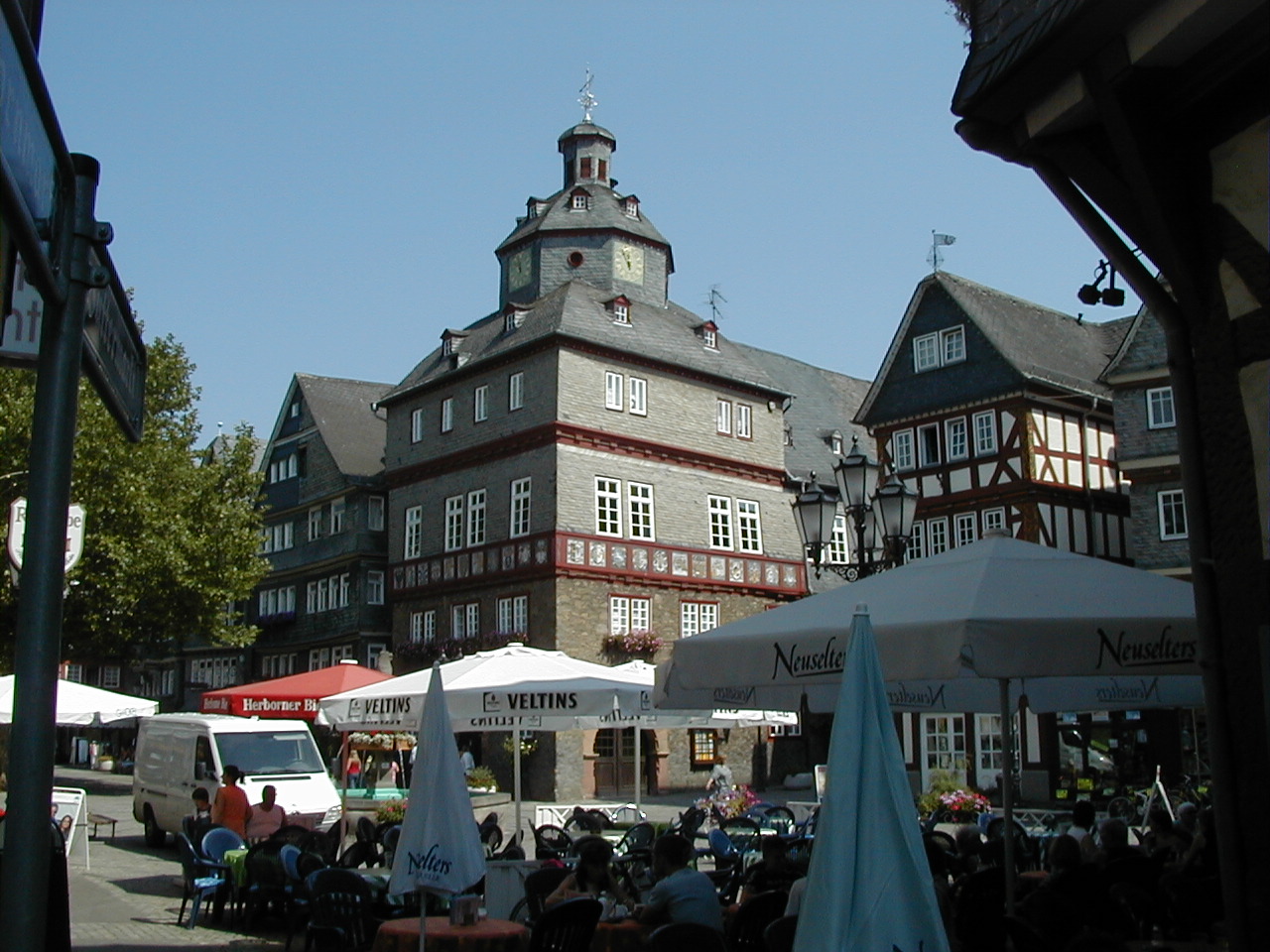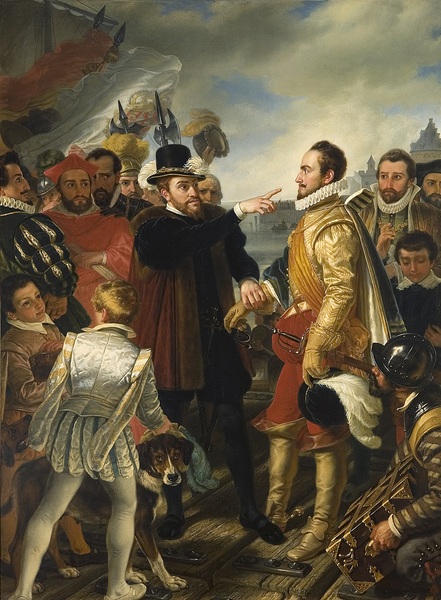|
Herborn, Hesse
Herborn () is a historic town on the Dill (river), Dill in the Lahn-Dill-Kreis, Lahn-Dill district of Hesse in Germany. Before World War I, it was granted its own title as ''Nassauisches Rothenburg ob der Tauber, Rothenburg''. The symbol or mascot of this town is a bear. Scenic attractions include its Timber framing, half-timbered houses; Herborn is located on the German Timber-Frame Road. Herborn hosted the 26th ''Hessentag'' state festival in 1986, and the 56th Hessentag in 2016. Geography The town's coordinates are . It has an area of , of which is forest. Herborn is connected by the Bundesautobahn 45, A45 motorway (European route E40, E40/European route E41, E41) with Siegen, Wetzlar, and Gießen. Neighbouring communities Herborn is bordered on the north by the town of Dillenburg, on the northeast by the community of Siegbach, on the east by the community of Mittenaar, on the southeast by the community of Sinn (Hesse), Sinn, on the south by the community of Greifenstein, and ... [...More Info...] [...Related Items...] OR: [Wikipedia] [Google] [Baidu] |
Hessisches Statistisches Landesamt
The statistical offices of the German states (German language, German: ) carry out the task of collecting official statistics in Germany together and in cooperation with the Federal Statistical Office of Germany, Federal Statistical Office. The implementation of statistics according to Article 83 of the Basic Law for the Federal Republic of Germany, constitution is executed at state level. The Bundestag, federal government has, under Article 73 (1) 11. of the constitution, the exclusive legislation for the "statistics for federal purposes." There are 14 statistical offices for the States of Germany, 16 states: See also * Federal Statistical Office of Germany References {{Reflist National statistical services, Germany Lists of organisations based in Germany, Statistical offices Official statistics, Germany ... [...More Info...] [...Related Items...] OR: [Wikipedia] [Google] [Baidu] |
Mittenaar
Mittenaar () is a municipality in the Lahn-Dill-Kreis in Hesse, Germany. Geography Mittenaar lies in the Lahn-Dill Highland. On Mittenaar's live more than 5,000 people. About 45 km of roads connect the various centres. More than half the municipal area is wooded. Mittenaar borders in the north on the community of Siegbach, in the northeast on the community of Bischoffen, in the east on the community of Hohenahr, in the southeast on the town of Aßlar, in the south on the community of Ehringshausen, in the southwest on the community of Sinn, and in the west on the town of Herborn (all in the Lahn-Dill-Kreis). The community consists of the centres of Ballersbach, Bellersdorf, Bicken (administrative seat) and Offenbach. History Mittenaar The community of Mittenaar came into being on 1 January 1972 with the merger of the formerly independent municipalities of Ballersbach, Bicken and Offenbach. Bellersdorf was amalgamated on 1 April 1972. Ballersbach Ballersbach had its ... [...More Info...] [...Related Items...] OR: [Wikipedia] [Google] [Baidu] |
Bible
The Bible is a collection of religious texts that are central to Christianity and Judaism, and esteemed in other Abrahamic religions such as Islam. The Bible is an anthology (a compilation of texts of a variety of forms) originally written in Hebrew, Aramaic, and Koine Greek. The texts include instructions, stories, poetry, prophecies, and other genres. The collection of materials accepted as part of the Bible by a particular religious tradition or community is called a biblical canon. Believers generally consider it to be a product of divine inspiration, but the way they understand what that means and interpret the text varies. The religious texts were compiled by different religious communities into various official collections. The earliest contained the first five books of the Bible, called the Torah in Hebrew and the Pentateuch (meaning 'five books') in Greek. The second-oldest part was a collection of narrative histories and prophecies (the Nevi'im). The third co ... [...More Info...] [...Related Items...] OR: [Wikipedia] [Google] [Baidu] |
Reformed Church
Reformed Christianity, also called Calvinism, is a major branch of Protestantism that began during the 16th-century Protestant Reformation. In the modern day, it is largely represented by the Continental Reformed Christian, Presbyterian, Congregational, and Waldensians traditions, as well as parts of the Methodist, Anglican (known as "Episcopal" in some regions) and Baptist traditions. Reformed theology emphasizes the authority of the Bible and the sovereignty of God, as well as covenant theology, a framework for understanding the Bible based on God's covenants with people. Reformed churches emphasize simplicity in worship. Several forms of ecclesiastical polity are exercised by Reformed churches, including presbyterian, congregational, and some episcopal. Articulated by John Calvin, the Reformed faith holds to a spiritual (pneumatic) presence of Christ in the Lord's Supper. Emerging in the 16th century, the Reformed tradition developed over several generations, esp ... [...More Info...] [...Related Items...] OR: [Wikipedia] [Google] [Baidu] |
Johannes Piscator
Johannes Piscator (; ; 27 March 1546 – 26 July 1625) was a German Reformed theologian, known as a Bible translator and textbook writer. He was a prolific writer, and initially moved around as he held a number of positions. Some scholarly confusion as to whether there was more than one person of the name was addressed in a paper by Walter Ong. Life Piscator was born at Strasbourg, and educated at the University of Tübingen. He became professor of theology at Strasbourg in 1573. Elector Frederick III experienced some resistance when he attempted to appoint him to the arts faculty at the University of Heidelberg in 1574, and Piscator eventually took a post at the preparatory Latin ''Paedagogium'' in Heidelberg Heidelberg (; ; ) is the List of cities in Baden-Württemberg by population, fifth-largest city in the States of Germany, German state of Baden-Württemberg, and with a population of about 163,000, of which roughly a quarter consists of studen .... After a confe ... [...More Info...] [...Related Items...] OR: [Wikipedia] [Google] [Baidu] |
Gymnasium (school)
''Gymnasium'' (and Gymnasium (school)#By country, variations of the word) is a term in various European languages for a secondary school that prepares students for higher education at a university. It is comparable to the US English term ''University-preparatory school, preparatory high school'' or the British term ''grammar school''. Before the 20th century, the gymnasium system was a widespread feature of educational systems throughout many European countries. The word (), from Greek () 'naked' or 'nude', was first used in Ancient Greece, in the sense of a place for both physical and intellectual education of young men. The latter meaning of a place of intellectual education persisted in many European languages (including Albanian language, Albanian, Bulgarian language, Bulgarian, Czech language, Czech, Dutch language, Dutch, Estonian language, Estonian, Greek language, Greek, German language, German, Hungarian language, Hungarian, Macedonian language, Macedonian, Montene ... [...More Info...] [...Related Items...] OR: [Wikipedia] [Google] [Baidu] |
William The Silent
William the Silent or William the Taciturn (; 24 April 153310 July 1584), more commonly known in the Netherlands as William of Orange (), was the leader of the Dutch revolt against the Spanish Habsburg Netherlands, Habsburgs that set off the Eighty Years' War (1568–1648) and resulted in the formal independence of the Dutch Republic, United Provinces in 1648. Born into the House of Nassau, he became Prince of Orange in 1544 and is thereby the founder of the House of Orange-Nassau, Orange-Nassau branch and the ancestor of the monarchy of the Netherlands. In the Netherlands, he is also known as Father of the Nation, Father of the Fatherland (; ). A wealthy nobleman, William originally served the Habsburgs as a member of the court of Margaret of Parma, governor of the Spanish Netherlands. Unhappy with the centralisation of political power away from the local estates and with the Spanish persecution of Dutch Protestants, William joined the Dutch uprising and turned against his fo ... [...More Info...] [...Related Items...] OR: [Wikipedia] [Google] [Baidu] |
John VI Of Nassau-Dillenburg
Count John VI of Nassau-Dillenburg (22 November 1536 – 8 October 1606) was the second son of William the Rich and the younger brother of William the Silent. He has a special place in the history of the Netherlands because he is the male-line forefather of the House of Orange. John VI of Nassau-Dillenburg was a Count of Nassau in Dillenburg. Other names he had were ''Jan VI'' or ''Jan de Oude'' ("John the Elder", to distinguish him from his 2nd son, "John the Middle", and his grandson "John the Younger"). John VI was born in Dillenburg, the second son of Count William I of Nassau-Dillenburg and his second wife Juliane of Stolberg-Wernigerode and brother of William I of Orange. He was the principal author of the Union of Utrecht. Family and children John VI was married three times and had a total of 24 children: First, he was married on 16 June 1559 with Elisabeth of Leuchtenberg (ca. March 1537 – 6 July 1579), who bore him 13 children: # Count Willem Lodewijk "Us H ... [...More Info...] [...Related Items...] OR: [Wikipedia] [Google] [Baidu] |
Herborn Academy
The Herborn Academy () was a Calvinist institution of higher learning in Herborn from 1584 to 1817. The Academy was a centre of encyclopaedic Ramism and the birthplace of both covenant theology and pansophism. Its faculty of theology continues as the Theological Seminary of the Evangelical Church of Hesse and Nassau. The institution held the principle that every theory has to be functional in practical use, therefore it has to be didactic (i.e. morally instructive). History In 1584 Count John VI of Nassau-Dillenburg founded the ''Academia Nassauensis'' as a post-secondary institution. He established it upon the request of his brother William the Silent, Prince of Orange in the year of the latter's death. The sovereign granted the students two warm meals and three liters of small beer per day. The Academy (Paedagogium) was originally located in the Herborn Castle. In 1588 Johann purchased the old town hall of Herborn and, after expanding it, gave it over for the Academy� ... [...More Info...] [...Related Items...] OR: [Wikipedia] [Google] [Baidu] |
House Of Nassau
The House of Nassau is the name of a European aristocratic dynasty. The name originated with a lordship associated with Nassau Castle, which is located in what is now Nassau, Rhineland-Palatinate, Nassau in Rhineland-Palatinate, Germany. With the fall of the Hohenstaufen dynasty in the first half of the 13th century, royal power within Franconia evaporated and the former stem duchy fragmented into separate independent states. Nassau emerged as one of those independent states as part of the Holy Roman Empire. The lords of Nassau were originally titled "Counts of Nassau", subject only to the Holy Roman Emperor, Emperor, and then elevated to princely rank as "Princely Counts". Early on, the family divided into two main branches – the elder (Walramian) branch, which gave rise to the German king Adolf, King of the Romans, Adolf, and the younger (Ottonian) branch, which gave rise to the Prince of Orange, Princes of Orange and the King of the Netherlands, monarchs of the Netherlands. ... [...More Info...] [...Related Items...] OR: [Wikipedia] [Google] [Baidu] |
Breitscheid (Hesse)
Breitscheid is a municipality in the Lahn-Dill-Kreis in Hesse, Germany. Geography Location Breitscheid lies from 266 to 600 m above sea level on the eastern slope of the Westerwald range at the point shared by three German states: Hesse, Rhineland-Palatinate and North Rhine-Westphalia. Erdbach, a constituent community, lies in an interesting place with regards to Earth's history, in the eastern part of the Westerwald, near that range's highest peak, Fuchskauten (657 m). Geology In the Erdbach area are noteworthy limestone deposits from various geological time periods. "Erdbach limestone" from Lower Carboniferous times gave an era the name "Erdbachium". The Erdbach – the village's namesake brook – disappears into a karst system, and does not appear again for 1.5 km where it can be seen in a quarry. Not far from there, the "Homberg" fossil reserve was instituted, which serves some university institutes from Jena to the Rhine as a research area. The older limestone fo ... [...More Info...] [...Related Items...] OR: [Wikipedia] [Google] [Baidu] |






